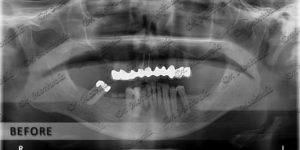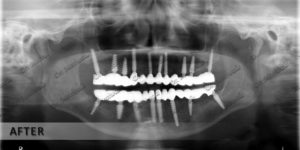Dental Bone Graft Cost and its Complications
Do You Have Dental Bone Graft Cost and its Complications – Not Enough Bone?
Bone grafting or bone augmentation article is your. If you have that you have Dental Bone Graft Complications may not have enough bone for dental implants do not despair! Implant dentistry has evolved and come to a full circle regarding bone grafting. In the early years of implant dentistry, it was extensively used for any bone volume deficiency.
Highly successful basal implants, short implants (Bicon implants length 5 mm), pterygoid implants, and Zygomatic implants indicate that there is no need for bone augmentation any more. Native or original cortical bone is more than enough for these techniques for immediate loading. (See permanent teeth in 3 days)


Discussion about Bone grafting
Bone grafts have also been used to restore bone contour for esthetic purposes which have now been replaced with very good results with less the invasive connective tissue grafts. Here we are going to .

What is bone grafting?
It is used to reconstruct bone and soft supporting tissue which lost due to any gum disease. Bone grafting also called by regenerative surgery. It may also be used to maintain bone structure after extraction of the tooth.
Why use bone grafting?
One of the gum diseases named periodontitis, which treatment by regenerative surgery. People who affected by periodontitis lose gum coverage and bone support around their teeth and regenerative surgery helps to regrow all of these lost tissues.
Preparations before surgery
Previous to this surgery, you have to need few periodontal treatments called root planning.
Recent view of implant placement
Brush twice a day and floss daily to take a good care of your teeth. Today it is considered highly preferable to place implants in original bone which is more highly mineralized in comparison to grafted bone which is less mineralized (less strong).
As such Sinus Grafting, Block Grafts, and Guided Bone Augmentation are not being used by experts. Techniques have been devised to avoid the aggressive bone grafting by placing just 4 or 6 implants in the jaw’s front part, and placing a set of just 10 or 12 cantilevered teeth. Permanent Teeth in 3 days technique allows a set of 14 teeth, because of placement of the upper jaw (pterygoid implant) and lower jaw (BOI implant) in the posterior jaw. Permanent Teeth in 3 days safely prevent cantilevers and also bone grafting while at the same time allowing immediate loading.

How it’s done?
The aim of this surgery is to glut the body into rebuilding the bone and other structures which add to a tooth jaw. A periodontist does this operation. A periodontist is a dentist who specializes in treating and gum diagnosing diseases.
At first, the periodontist will detach the gums from the teeth to reach access to the root later bons. Then, the roots will be carefully clean by all side. That defected hole of the bone will be filled by grafted materials. After that, they will be covered by a physical barrier.
Bone grafting material usually includes:
- Your own bone
- Synthetic glasses
- Cow bone
- Cadaver bone
After the surgery, it will take some time to set the draft in the place. The place also covered with a bandage known as a periodontal pack or else dressing. During the next 6 to 10 months, the area starts filling with new soft tissue and bone. For that your tooth starting to re-attached your jaw.
Follow up
- Have the medicine which your doctor recommends.
- Keep your mouth as clean as possible. Brush twice a day, use floss and mouth cleaner.
- After surgery, if have a smelling problem then reduce swelling by using an ice pack to the outside of your face in the site.
- Take antibiotics if need.
- Follow the instructions of the doctor.
Dental bone graft complications
- Unpredictable in healing(always some percentage of volume shrinkage).
- Infected while healing.
- Not as strong as original native bone.
- Dental bone graft cost is expensive.
- Unnecessary surgical procedure.
- Long treatment time (6 to 12 months).
When to call your doctor?
Your periodontist will monitor you closely after the surgery. During next few months, you need to go for the examination. In addition, call your periodontist if you have unstoppable bleeding or suffering from unbearable pain or the surgical area becomes swollen. It is probably a sign of developing an infection which must be treated early as possible. After a successful surgery, bone grafting can help to cure many kinds of gum disease.
